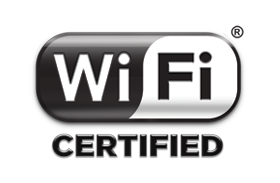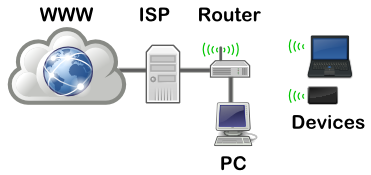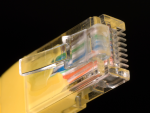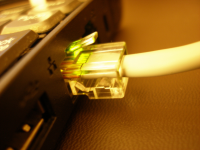Home Wireless Network Configuration
This article gives an overview on the configuration options for a WiFi network at home or in an office, also known as Small Office/Home Office or SOHO. It covers WiFi hardware, what a booster is and some of the problems that can occur due to WiFi signal issues.

WiFi Topology and WiFi Booster Options for SOHO
The basic network layout for an Internet connection is discussed and shown. The options to boost and extend the network to support areas with a poor WiFi signal are illustrated.
What is WiFi?
The term WiFi is used to describe a wireless connection from a device (laptop, tablet or phone) to the Internet. A network connection without cables is also called an untethered connection. What WiFi is doing is connecting a WiFi enabled device to an Access Point (AP). The AP is referred to as a hub, router, gateway or modem. In fact an AP is a box that combines what used to be several devices into one unit, these devices being a router, a modem, a network switch and a wireless local area network (WLAN) interface. The AP then communicates over cable to the server (computer) of the Internet Service Provider (ISP) who provides the broadband (data) connection. For telephone lines the data connection is referred to as ADSL Broadband. Where ADSL (Asymmetric Digital Subscriber Line) is the technology used to send high speed data over telephone lines originally designed for voice communications. Fibre optic connections are also run to homes and offices to provide much higher data rates than available over copper telephone wire.

The ISP is usually the same company that provides you with a home telephone line, although the Internet broadband connection can be provided by a separate company. There is usually a saving in getting both the telephone line and broadband connection from the same supplier. The ISP server handles the link to the Internet (World Wide Web). The link from the ISP to your home is normally through either telephone cable, coaxial cable or fiber optic cable (fiber is spelt fibre in the UK). Combinations of those cables can be used, e.g. for fiber connections often coaxial cable or telephone cable is used between the roadside cabinet and the home (unless fiber to the home is being provided).
The WiFi Name
The WiFi term (original with a dash: Wi-Fi) was coined by the group of companies that came together to promote the wireless networking technology. It was intended to represent the phrase Wireless-Fidelity, similar to the term Hi-Fi (High-Fidelity) being used to refer to audio equipment. Look for the WiFi Certified logo when buying WiFi enabled products.
Hub or Router or Gateway or Modem or Access Point
All of these terms can refer to the same box that is installed to connect your house to the Internet. The term hub or media hub or super hub is being used to describe this box to acknowledge the fact that the box combines several functions that used to be performed by different boxes in the past. The term Access Point (AP) also generally refers to any point that a wireless device can connect to a network, and not just the box that connects to the Internet. Therefore in this article we will use the term hub to refer to the box installed by the ISP (usually the phone company or television\satelitte company). Sometimes the hub is sent to the house with connection instructions, or a purchased hub can be used. This is usually for broadband provided via the standard telephone socket.
The Basic Home or Small Office Network

This is the basic layout of the network when a hub (router) has been installed. The telephone is not shown because it is usually separated from the data network at the point the cables enter the house (with standard telephone lines ADSL filters are used to separate the voice and data signals). This network is typical of the type in use in a home, or small office (SOHO). (The clip-art for the diagrams in this article is from the Open Clip Art Library.)

The devices that do not have WiFi capability normally plug straight into the back of the hub using a network cable. The network cable is also referred to as an Ethernet cable, RJ45 cable, Cat 5 cable, Cat 6 cable or network patch cable. (Picture from Wikimedia Commons.)
The number of sockets on a hub for plugging in network cables can vary. Some have only one, some up to eight or more. Four is a common number. A socket will be used to gain wired access to the hub to enable configuration changes in certain circumstances. While it is common to connect a printer directly to a PC, in a SOHO setup some printers come with RJ45 connections to allow plugging into the hub. Many printers now support WiFi to support wireless printing from many devices, and avoid the need to plug into a PC or hub.
Dealing With a Poor WiFi Signal
The WiFi signal from a hub may not be very strong, and like other radio signals it can suffer from interference. The interference is from other electrical devices and also WiFi connections from neighboring properties. The further the signal has to travel, and the more obstacles (walls) it needs to penetrate, the weaker it becomes. Ideally the hub needs to sit in a central location in a building, but often it is located in the corner of a room on a ground floor. This usually causes a weak signal in upstairs rooms furthest from the room containing the hub. This can result in no WiFi connection, or poor connections that are dropped regularly or operate at slower speeds. There are several ways to improve network connections in the locations that have poor WiFi signals.
- Move the hub to a higher or more central location. Before the hub is installed look around for a suitable location. Remember that a cable will need to be run to it by the installers and that a power outlet will be needed. If it has already been installed then see if it can be moved, even putting it on top of a cabinet or a high shelf can help.
- Change the transmission channel the hub is using. There are up to 14 channels for WiFi transmission, though there is some overlap depending upon how the router is using the channels, see the diagram below from Wikipedia. There may be a better (less crowded) channel available for the signal. WiFi analyzer software can help determine the clearest channel to use.
- Use a WiFi repeater, also known as a WiFi booster, WiFi extender or WiFi range extender. These are Access Points (WiFi routers) configured to relay the WiFi signal onward.
- Use an Access Point in combination with fixed networking cabling. Use fix cabling to extend the network, although this may requiring running a cable through one or more walls.
- Use an Access Point in combination with power line networking. Networking using the power cables in a building is possible with a power line communication adapters. This removes the need to run new cables in a building.

Wireless Router Configured for WiFi Repeating
A WiFi router is a mass produced product so they are a reasonable cost. There have been so many WiFi routers sold there are readily available used units for little cost on auction sites. Most wireless routers can be configured as a repeater, aka extender. In this configuration they relay the data from the hub to the remote WiFi device and back again.

When configuring an Access Point for repeating they can operate in on of two repeating modes, WDS repeating or as a universal repeater. In Wireless Distribution System (WDS) mode WiFi routers from the same manufacturer can relay data between themselves. If the routers are not from the same manufacturer then the universal repeater mode is required. The hubs provided by ISPs do not normally support WDS (because only one is ever expected to be provided), therefore to use a WiFi repeater to extend the range of a hub it needs to be configured as a universal repeater.
Configuring a WiFi Router as a Repeater/Extender
Instructions for re-configuring a wireless router as a repeater are normally supplied with the device or on the support section of the manufacturers web site. Normally the router being setup is plugged into a computer using a network cable. A configuration page is accessed on the router by typing a network address into the computer's browser. The relevant changes are made and the router is then rebooted. (Picture from Wikimedia Commons.)

If using a laptop to perform the configuration changes any existing wireless networks may need to be disabled or deleted so that the configuration page can be loaded. The computers TCP/IP properties may also need to be temporarily changed in order to get access to the router configuration. The instructions will show how to do this.
When the router's configuration pages are shown there will be an option to select the operating mode. With repeater mode selected (not a WDS repeater) there may be a search or survey button enabled. This will list the other Access Points the router can see. Normally using a list of the service set identifications (SSIDs), aka the WiFi network names. The hub will be one of them (if powered on and in range). Select the hub that is to be repeated. If no option to search or survey is provided the settings for the repeater will need to come from the hub configuration.
The router configured as a universal repeater must mimic the hub. Therefore the security settings for the router need to be set the same as the security settings for the hub. There will be a wireless security page in the router's configuration. Set the router's security to the same as the hub's security configuration.
The hub's configuration is accessed in the same way as the repeating router, by using a direct wired connection from a laptop or PC to the hub. The ISP's support pages will give instructions on accessing the hub's configuration pages. The configuration will not normally need to be changed. Just accessed for any settings required, namely it's WiFi name (SSID), network address, security mode and passkey (pass phrase). Some of these may be printed on the rear of the hub if the defaults have not been changed.
Use a Wired Access Point to Extend a SOHO Network
A WiFi router can be plugged into a hub, this then creates another WiFi network at the remote location that the wireless devices can use.

The connection between the two Access Points can be done over the building power line using a power line communications adapter.

If you need to use the same SSID and pass phrase then the remote router needs to be set to bridge mode and the same security configurations as the base hub set (all done in a similar manner to configuring a router in repeater mode). This allows for roaming on the same network in a building (although on some older WiFi devices switching to the strongest signal is not automatic but can be achieved by turning the devices WiFi off then on again).
And Finally
If you need help with getting a home network working there plenty of resources on the Internet. Use a search engine to ask your question and appropriate web pages and forums should appear to provide the help. Do not get frustrated with the equipment, check each part of the chain from the hub outwards and only move to the next part once it is confirmed that part is functioning correctly. If equipment is WiFi compatible it is usually a configuration option that needs setting, occasionally it will be faulty equipment but that can be determined through a process of elimination.
See Also
For more Tek Eye articles see the full website Index.
Author:Daniel S. Fowler Published: Updated:







